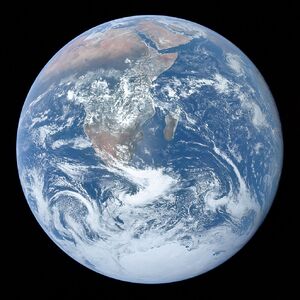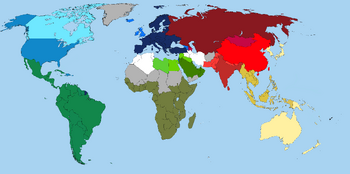
| |
| Earth | |
|---|---|
| Astrographical | |
| Region |
Local Cluster |
| Sector |
Human controlled space |
| System | |
| Suns |
Sol |
| Orbital position |
Third |
| Moons | |
| Trade routes |
Many |
| Rotation period |
24h |
| Orbital period |
365 days |
| Physical | |
| Class |
Garden, Semi-desert |
| Diameter |
12,764 |
| Atmosphere |
|
| Climate |
|
| Gravity |
1G |
| Primary terrain |
Miscellaneous |
| Points of interest |
Homeworld of Humanity |
| Native flora |
In Decay, Recovering |
| Native fauna |
In Decay, Recovering |
| Societal | |
| Native species | |
| Primary language(s) |
English, Spanish and |
| Government |
Confederacy |
| Population |
12.7 billion |
| Demonym |
Human, Earthling, Terran |
| Major cities |
New York, Shanghai, |
| Major imports |
Many, mainly raw materials |
| Major exports |
Many |
| Affiliation | |
The homeworld and capital of humanity is entering a new golden age. The resource wealth of a dozen settled colonies and a hundred industrial outposts in Sol and in two extrasolar systems flows back to Earth, fueling great works of industry, commerce, and art. The great cities are greening as arcology skyscrapers and telecommuting allow more efficient use of land.
Earth is divided among nation-states, though all are affiliated beneath the overarching banner of the UN. While every human enjoys longer and better life than ever (life span averaging 125 years), the gap between rich and poor widens daily. Advanced nations have eliminated most genetic disease and pollution. Less fortunate regions (UN's Pacified Zones) have not progressed beyond 20th century technology, and are often smog-choked, overpopulated slums with no arable land nor potable water.
Sea levels have risen two meters in the last 180 years, and violent weather is common due to environmental damage inflicted during the late 21st century, though a global satellite system of weather control is being built as part of the Phoenix Project . The past few decades, however, have seen significant improvement due to recent technological advances.
History[]
While chaos reigns in the forgotten corners of the Earth, in space prosperity and peace live side by side. The wealth of the Outer Planets has grown with the demand for energy on Earth, and the construction of the Space Elevators have opened Earth to more goods from the colonies than ever. Mars has been fully terraformed for more than 30 years. The Moon remains the refinery of the Solar System, as gasses from Jupiter and Saturn flow down system for a hungry society. The first warp drive capable ships were built
Government[]
See also: United Nations
The broad proceses of globalization during the XXI century and the menace of the Ki'sa generated the rise of a global-scale liberal democracy — one capable of ending nuclear proliferation, ensuring global security, intervening to end genocide (like they did in Persia in 2054), defending human rights, and putting a stop to human-caused climate change.
Globalization unfolded in four stages before the final convergence. The first phase was cultural globalization, the second economic, the third political and the fourth complete integration. The first, second, and third stages were largely complete by the year 2100, though some protectionism still remained. The final stage proved to be the most difficult; nation-states were incredibly hesitant to give up total sovereignty. But the discovery of the Ki'sa and their subsequent treats pushed national governments around Earth to give up their final traces of independence.
Social Democracy (with regional variants to left or right) is the most popular form for local governments.

World Political map
Armed Forces[]
See also: UNAF
The United Nation's military is divided into an Army and a Navy (that uses spacecraft instead of ships and doubles as an air force). Its conscripts come from all over the Earth and her colonies. Most of the soldiers are heavily enhanced and around 80% of them are Pod-Humans.
Earth is divided into 12 military commands:
- North America
- South America
- Europe
- Mediterranean Magreb
- Subsaharan Africa
- East Africa
- Middle East (includes Egypt)
- India
- Eurasia
- Southeast Asia
- East Asia
- Antarctica
Geography[]
Economy[]
Advances in technology during the last 100 years have made the Earth to look very different from what it looked like at te begging of the 21st century. Improvements in energy production and distribution, transport, extranet and urbanism transformed drastically the economy of the planet.
New and different economic hubs have appeared and prospered, like Antarctica, Central Africa, Central Asia, Siberia and South America. Moreover Europe, North America, and East Asia evolved to the maximum expression of social democracies: full democracies (in some cases demarchies) where the middle class is ubiquitous and the great wealth is evenly distributed.
Overpopulation, archologies, ubiquitous internet, genetics, fusion power, AIs, and theoretical immortality (by cybernetic or genetic means) created a world in which hunger, disease or access to education are no longer a synonym of poverty (for they've almost vanished), while access to better genecodes, quantum and molecular computing, and memetics define the level of wealth and are center stage of development and discrimination discussions.
Infrastructure[]
See: Vacuum Trains & Orbital Elevators
Travel time to*:
- Mars: 12 hours
- Domus Ruber: 9 weeks
- Imvusa Ikhaya: 6 weeks
- Zelenovaty: 4 weeks
- Rakkuuna: 6 weeks
*With human Alcubierre Drive
Demographics[]
Culture & Science[]
With the unstoppable march of globalization and integration that swept the world in the 21st century, alongside technologies such as in-time translators and virtual reality-- the languages that remain most prominent on earth are those that were extensively carried into space and used in century-defining technologies by the most powerful countries and hypercorps. No single language dominated, and multilingualism is common. Many habitats and (sub)cultural groupings cling to specific languages as a method of retaining cultural identity. Despite the avail- ability of instant translation, many people remain versed in two or more languages.
The ten languages with the largest speaking populations (in alphabetical order) are: Arabic, Cantonese, English, French, Hindi, Japanese, Mandarin, Portuguese, Russian, and Spanish. Other languages that remain strong include Bengali, Farsi, German, Italian, Javanese, Korean, Polish, Punjabi, Swahili, Swedish, Tamil, Turkish, Urdu, Vietnamese, and Wu. Some languages have been lost, especially those in undeveloped regions, as their speaking populations chose to teach their offspring global languages rather than local ones.
General Statics by Continent[]
| Continent | Population in millions | Biggest Economy | Main Corporations | Most Powerful Currnecy Besides Credit |
|---|---|---|---|---|
| World | 12,757 | China | Credit | |
| Africa | 2,970 | Nigeria | Armscor, Iroko & Nando | Naira ₦ |
| Antartica | 774 | --- | ||
| Asia | 5,671 | China | Mingsheng Co, Tata & Mitsubishi | Renminbi Yuan 元/¥ |
| Europe | 701 | European Union | Barclays, JCDecaux & Siemens | Euro € |
| Latin America | 827 | Mexico | Serrano Genomica, Industrias Mérida & Itau Unibanco Participacoes | Mexican Peso $ |
| North America (USA, Canada and Greenland) |
944 | USA | Tesla, Kiewit, Praxis | American Dollar $ |
| Oceania | 173 | Australia | QBE, AMP, Suncorp | --- |